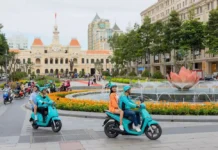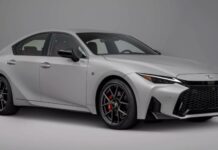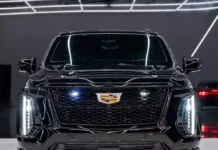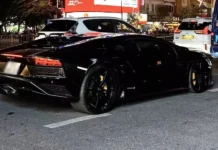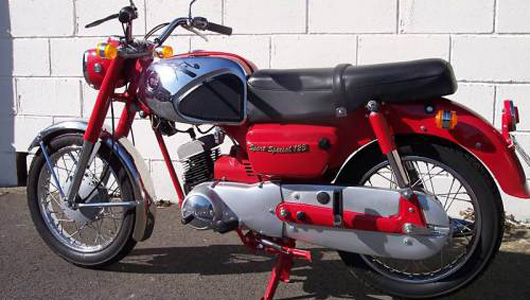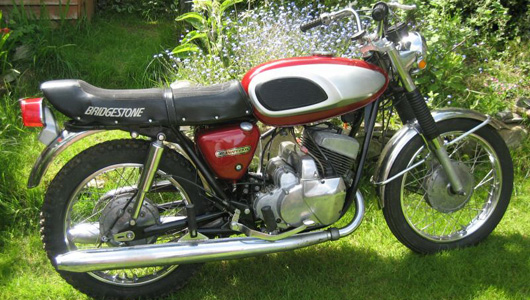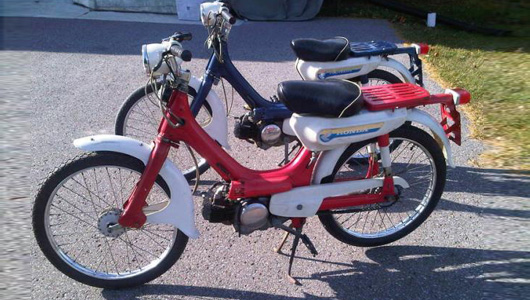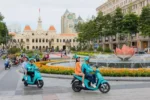Bicycles and motorbikes were the most common means of transportation in the South of Vietnam before 1975 and still are today. This article provides a comprehensive overview of the motorbikes that were present in the South before 1975.
>> You can comment on this article at http://www.facebook.com/Autodaily
>> Before 1975, what did people in Saigon ride? (Part 1)
>> Before 1975, what did people in Saigon ride? (Part 2)
The presence of the “big four”
All the “big four” Japanese motorcycle manufacturers – Honda, Yamaha, Suzuki, Kawasaki – were present in the South before 1975.
Suzuki introduced the M15 and M12 models for men and the Suzuki Dame and M31 models. The two male models were roughly similar, using the same engine, but the sporty model had a higher exhaust pipe and a shorter front fender for a sportier look.
Yamaha had two male models, including the YF5 model, and a Yamaha Dame model. The Yamaha male models were beautiful with shiny parts. The Yamaha Dame was painted sky blue and had gentle curves, making it look very artistic. Yamaha motorcycles seemed to be less popular than Honda motorcycles because their engines were not as powerful.
The Suzuki Dame and Yamaha Dame had lower headlights than the Honda Dame, which gave them a more gentle appearance suitable for girls wearing traditional ao dai dresses.
Kawasaki was the smallest Japanese motorcycle manufacturer at that time, with only one male model. Kawasaki motorcycles ran well but were criticized for being heavy and having weak engines. The motorcycles brought to Vietnam were the 80cc frame type, which were then replaced with a 50cc engine to be classified as mopeds, not requiring a license.
A less remembered brand is Bridgestone.
Bridgestone specialized in manufacturing tires but also had a division that produced racing motorcycles. The Bridgestone model brought to Vietnam in 1966 had a 65cc engine. As a result, Bridgestone motorcycles were very powerful. The feature of Bridgestone motorcycles was the four-speed gearbox, similar to racing motorcycles, meaning that when reaching the fourth gear, pressing the gear again would return to the first gear without going in reverse. Bridgestone motorcycles faded into obscurity for the Vietnamese people when the motorcycle division of the company closed in 1967 because other Japanese motorcycle manufacturers did not want to buy tires from their competitors for racing.
Japanese motorcycles dominate in Saigon
Unlike European motorcycle manufacturers who kept the same models for many years, Japanese manufacturers aggressively attacked the Vietnamese market with new models every year. In 1968, Honda launched the CL50 model. CL stands for Scrambler. It was a motorcycle designed to ride on uneven dirt roads, so it only had four gears, with strong acceleration in the first and second gears, but the maximum speed was lower than the Honda 67. The tall exhaust pipe was to avoid collisions with the ground or water.
In 1969, Honda introduced the SS50M model. It used the same engine and frame as the Honda 67, but had a longer fuel tank for a sportier look. In 1970, Honda introduced the CD50 model. This model also used the same frame and engine as the SS50, but had a different fuel tank and storage box design, making it look completely different. The motorcycle was designed for city riding, so it only had four gears with strong acceleration in the lower gears, suitable for the stop-and-go traffic in the city.
 Honda motorcycles flooding the streets
Honda motorcycles flooding the streets
Using the SS50E model, Honda introduced new models in 1971 and 1972 with metallic red paint and shiny fenders, high handlebars resembling bull horns, which made them more attractive. Honda changed the outward appearance to attract new customers. In 1969, Suzuki also introduced the AS50 model, which looked very sporty and beautiful. Besides the officially imported Honda models, occasionally on the streets of Saigon, there were rare Honda models such as the Honda Monkey, which was tiny like a kid’s motorcycle, or the Honda CT50, CT70, with the letter T standing for Trail, a type of Honda motorcycle used for leisure rides in the countryside, but in Vietnam it became a means of transportation for going to school and work.
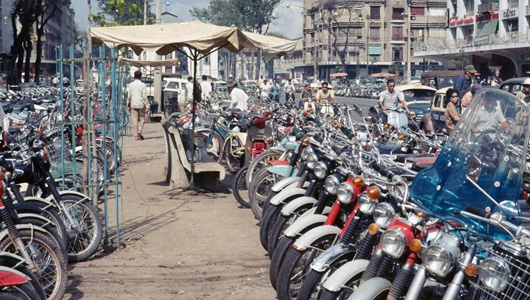 A parking lot full of Japanese motorcycles
A parking lot full of Japanese motorcycles
Among all Japanese motorcycles, only Honda used a four-stroke engine, with separate fuel and oil compartments, while other brands used two-stroke engines, running on mixed fuel and oil.
With a wide variety of motorcycles introduced to the market, the streets of the South became lively with colorful motorcycles. Saigon’s streets were bustling with motorcycles, revving engines, and loud noises. Honda motorcycles were actually very quiet when running. However, many users removed the noise suppressor at the end of the exhaust pipe, causing the engine to make more noise. This suppressor was as small as a drainpipe, with many holes in the body, about the length of an arm. Simply removing the small screw at the end of the exhaust pipe could remove the suppressor. The reason for removing the noise suppressor was that users found the motorcycle to run faster without it.
From small motorcycles…
There were more motorcycles in Saigon, and it became more dangerous because Japanese motorcycles ran fast and accelerated quickly. Therefore, some parents were concerned about buying motorcycles that were too powerful for their children. Honda introduced the PC50 model, which also used a 50cc engine but did not require shifting gears and did not accelerate as quickly as motorcycles with gears. The top speed was around 60 km/h. The PC50 model was an improved version of the P50, with the engine placed in the middle for better balance and suspension in both the front and rear wheels. The use of the PC50 was as simple as the Mobylette, just kick-starting the engine and twisting the throttle to go.
Motobécane also introduced the small and compact Cady model, suitable for students. The name Cady may come from the word Cadet, indicating that it was the youngest model in the Motobécane family. Although it also used a 50cc engine, the motorcycle could only reach a maximum speed of 40 km/h. Slow speed seemed like a disadvantage of the motorcycle, but it was actually an advantage because it reassured parents when buying motorcycles for their children. With the trend of colorful design in the early 1970s, the Cady motorcycle was initially painted brown or gray, then later painted in various bright colors like blue, red, and yellow. Along with the appearance of mini skirts, the streets of Saigon saw the appearance of mini Cady motorcycles with two small wheels, which looked very cute. At the same time, mini bicycles also appeared, and teenage girls wearing mini ao dai dresses looked youthful, vibrant, and riding colorful mini motorcycles.
… to “brave highways”
Highway to Bien Hoa, now known as Hanoi Highway, had very few vehicles at that time, so it became a testing and racing ground for motorcycles. Various types of motorcycles were brought out to test their top speed during off-peak hours. Although there were no reviews or ratings of motorcycles, the advantages and disadvantages of each type were widely spread by word of mouth. Two-stroke motorcycles, although they could run fast, would become weaker and slower at high speeds after a few hours of continuous running. Only Honda motorcycles after 1965 were praised for maintaining their speed when running hot. Honda improved the lubrication system, causing the oil to be injected into the engine more, preventing friction from slowing down the speed. Other Honda models such as the S65 and C110, although they could reach speeds of over 100 km/h, also slowed down when running hot.
To increase the power of the motorcycles, the piston was modified to increase the displacement from 50cc to 60cc or 70cc. Motorcycles with modified piston ran faster and could reach speeds of over 100 km/h if the engine was properly tuned.
A popular game among motorcycle enthusiasts was called “beating the be”. The word “be” came from the word “anh be”, meaning “hero” in Vietnamese, because racing motorcycles was considered brave but not praiseworthy. “Be” referred to a wooden stick that was five or six meters long. One end of the stick was tied to the front of a cargo bike, while the other end was attached to the rear trailer, with nothing else connecting the cargo bike and the rear trailer. The distance from the trunk of the stick to the road surface was just over one meter. Racers would try to crawl under the cargo bike from one side to the other. Because the height was low, they couldn’t run straight but had to tilt the motorcycle to pass through. If they miscalculated the timing, the riders could be hit and run over by the rear wheels.
Motorcycles were a means of transportation, but they were also a symbol of the speed-loving youth and the attraction of colors, styles, and engine sounds. This obsession is etched in the memories of many people in the South at that time and remains vivid over time. It has become a beautiful memory every time they recall the moment of bringing a brand new motorcycle home and the days of traveling on iron horses.
Thế Đạt (Source: PL&XH/Nguồn: Honda67)


